Quantitative Assessment of Rock Burst Risk in Roadway Tunneling Considering Variation of Coal Mass Parameters
Abstract
1. Introduction
2. Engineering Cases and Discrete Element Modeling
3. Variation of Mechanical Parameters in the Coal Mass
4. Results of Roadway Tunneling Simulation
4.1. Determination of Burst-Prone Area around the Roadway
4.1.1. Displacement Analysis of Coal and Rock Mass during Roadway Tunneling
4.1.2. Velocity Analysis of Coal and Rock Mass during Roadway Tunneling
4.2. Energy Analysis of Coal Mass under Parameter Variation
4.3. Analysis of Rock Burst Damage Energy under Different Ground Stresses
5. Quantitative Assessment of Roadway Rock Burst Risk
5.1. Discrimination Parameters for Roadway Rock Burst Risk
5.2. Quantitative Analysis of Roadway Rock Burst Risk
6. Conclusions
- Rock burst risk can occur even with relatively low kinetic energy within the coal mass, according to the analysis of the displacement and kinetic energy patterns in the roadway side during tunneling. Areas adjacent to the side of the roadway exhibit a higher susceptibility to stress disturbances induced by tunneling, leading to an increased stress gradient difference in the coal mass near the side zone, thereby resulting in burst phenomena. The released kinetic energy and rock burst risk are associated with the ground stress change.
- With the consideration of the effects of variation in the mechanical parameters of coal mass on rock burst, a relationship between coal mass mechanical properties and rock burst is established. This relationship elucidates the connection between rock burst risk during roadway tunneling and the mechanical parameters of coal mass, indicating that the varied values of these parameters significantly influence the induction of rock burst risk.
- A clear linear relationship exists between the coefficient of variation (COV) of coal- mass parameters and the occurrence of rock burst in roadway sides. The variation of the COV in the internal friction angle and cohesion exhibits positive and negative correlations with burst risk, respectively. An increased COV in cohesion heightens the likelihood of significant deformation in the side during roadway tunneling, which, consequently, elevates the rock burst risk.
Author Contributions
Funding
Institutional Review Board Statement
Informed Consent Statement
Data Availability Statement
Acknowledgments
Conflicts of Interest
References
- Jiang, Y.; Zhao, Y. State of the art: Investigation on mechanism, forecast and control of coal bumps in China. Chin. J. Rock Mech. Eng. 2015, 34, 2188–2204. [Google Scholar]
- Jiang, Y.-D.; Pan, Y.-S.; Jiang, F.-X.; Dou, L.-M.; Ju, Y. State of the art review on mechanism and prevention of coal bumps in China. J. China Coal Soc. 2014, 39, 205–213. [Google Scholar]
- Vardar, O.; Zhang, C.; Canbulat, I.; Hebblewhite, B. A semi-quantitative coal burst risk classification system. Int. J. Min. Sci. Technol. 2018, 28, 721–727. [Google Scholar] [CrossRef]
- Pan, Y.; Song, Y.; Liu, J. Pattern, change and new situation of coal mine rockburst prevention and control in China. J. Chin. J. Rock Mech. Eng. 2023, 42, 2081–2095. [Google Scholar]
- Pan, Y.-S.; Geng, L.; Li, Z.-H. Research on evaluation indices for impact tendency and danger of coal seam. J. China Coal Soc. 2010, 35, 1975–1978. [Google Scholar]
- Gu, R.; Ozbay, U.J.C. Numerical investigation of unstable rock failure in underground mining condition. Comput. Geotech. 2015, 63, 171–182. [Google Scholar] [CrossRef]
- Wu, H.; Liu, Y.; Wang, G.; Liu, X.; Yuan, K.; Li, G. Stability analysis of surrounding rock of roadwayunder dynamic load rock burst based on discrete element method. J. China Min. Mag. 2022, 31, 118–123. [Google Scholar]
- Zhao, S.; Qi, Q.; Li, Y.; Deng, Z.; Li, Y.; Su, Z.G. Theory and practice of rockburst stress control technology in deep coal mine. J. China Coal Soc. 2020, 45, 626–636. [Google Scholar]
- Wang, E.; Feng, J.; Zhang, Q.; Kong, X.; Liu, X. Mechanism of rockburst under stress wave in mining space. J. China Coal Soc. 2020, 45, 100–110. [Google Scholar]
- Zuo, J.; Wei, X.; Wang, J.; Liu, D.; Cui, F. Investigation of failure mechanism and model for rocks in deep roadway under stress gradient effect. J. China Univ. Min. Technol. 2018, 47, 478–485. [Google Scholar]
- Liu, G.; Wang, Z.; Cui, Y.; Ma, Q.; Yan, L.; HAN, Y. Mechanism of rock burst in deep coal tunnel surroundings due to three-way stress difference gradient. J. China Coal Soc. 2023, 48, 2106–2122. [Google Scholar]
- Zhang, S.; Zhao, J.; Li, S.; Zhou, T.; Cui, X.; Zhang, D.; Liang, J.; Wang, G.; Zhu, S.; Sun, B. Study on impact risk assessment of isolated coalmass in roadway of thick coal seam in deep mine. J. Saf. Sci. Technol. 2022, 18, 70–77. [Google Scholar]
- Agrawal, H.; Durucan, S.; Cao, W.; Korre, A.; Shi, J.-Q. Rockburst and gas outburst forecasting using a probabilistic risk assessment framework in longwall top coal caving faces. Rock Mech. Rock Eng. 2023, 56, 6929–6958. [Google Scholar] [CrossRef]
- Wojtecki, Ł.; Iwaszenko, S.; Apel, D.B.; Bukowska, M.; Makowka, J. Use of machine learning algorithms to assess the state of rockburst hazard in underground coal mine openings. J. Rock Mech. Geotech. Eng. 2022, 14, 703–713. [Google Scholar] [CrossRef]
- Zhang, K.; Fang, H.; Li, S.; Shen, R.; Ren, S. Microseismic monitoring and prevention of working face rockburst in thick coal seam with hard roof and large buried depth. J. China Min. Mag. 2021, 30, 77–83. [Google Scholar]
- Wang, Y.; Gong, D. Study on the microseismic signal characteristics and energy change in the coal mine working face. J. China Min. Mag. 2020, 29, 209–212. [Google Scholar]
- Han, Z.; Shi, X.; Shen, Y.; Zhang, X.; Chen, H.; Zhu, G. Spatio-temporal monitoring and pre-warning technology for rockburst in deep geological structure areas. China Min. Mag. 2024, 33, 147–154. [Google Scholar]
- Wu, Y.; Hao, Y.; Pu, H.; Shen, L.; Zhang, Y.; Geng, H. Energy evolution model and rock burst risk assessmcnt for dcformation and failure of coal-rock mass. J. China Min. Mag. 2022, 39, 1177–1186. [Google Scholar]
- Guo, X.; Guo, L.; Li, C.; Ma, N.; Zhao, Z.; Huo, T. A quantitative assessment method of roadway rockburst risk based on the plastic zone shape coefficient. J. China Univ. Min. Technol. 2021, 50, 39–49. [Google Scholar]
- Jaiswal, M.; Sebastian, R.; Mulaveesala, R. Thermal monitoring and deep learning approach for early warning prediction of rock burst in underground structures. J. Phys. D Appl. Phys. 2023, 57, 105502. [Google Scholar] [CrossRef]
- Askaripour, M.; Saeidi, A.; Rouleau, A.; Mercier-Langevin, P. Rockburst in underground excavations: A review of mechanism, classification, and prediction methods. Undergr. Space 2022, 7, 577–607. [Google Scholar] [CrossRef]
- Qi, Q.; Li, H.; Li, X. Qualitative and quantitative evaluation of impact risk in underground mine. J. Coal Sci. Technol. 2021, 49, 12–19. [Google Scholar]
- Zhang, T. Simulation Study on the Law of Rock-Burst Appearance in Coal Roadway Excavation. Master’s Thesis, China University of Mining and Technology, Xuzhou, China, 2019. [Google Scholar]
- Wang, Y.; Zhao, Y.; Zhang, H.; Lin, X. 2-D normal distribution-based study onparameter selecting range for shear strength of rock mass. J. Water Resour. Hydropower Eng. 2017, 48, 74–78+96. [Google Scholar]
- Zeng, P.; Zhang, T.; Li, T.; Jimenez, R.; Zhang, J.; Sun, X. Binary classification method for efficient and accurate system reliability analyses of layered soil slopes. Georisk Assess. Manag. Risk Eng. Syst. Geohazards 2022, 16, 435–451. [Google Scholar] [CrossRef]
- Zhang, G.; Li, Y.; Meng, X.; Tao, G.; Wang, L.; Guo, H.; Zhu, C.; Zuo, H.; Qu, Z. Distribution Law of In Situ Stress and Its Engineering Application in Rock Burst Control in Juye Mining Area. Energies 2022, 15, 1267. [Google Scholar] [CrossRef]

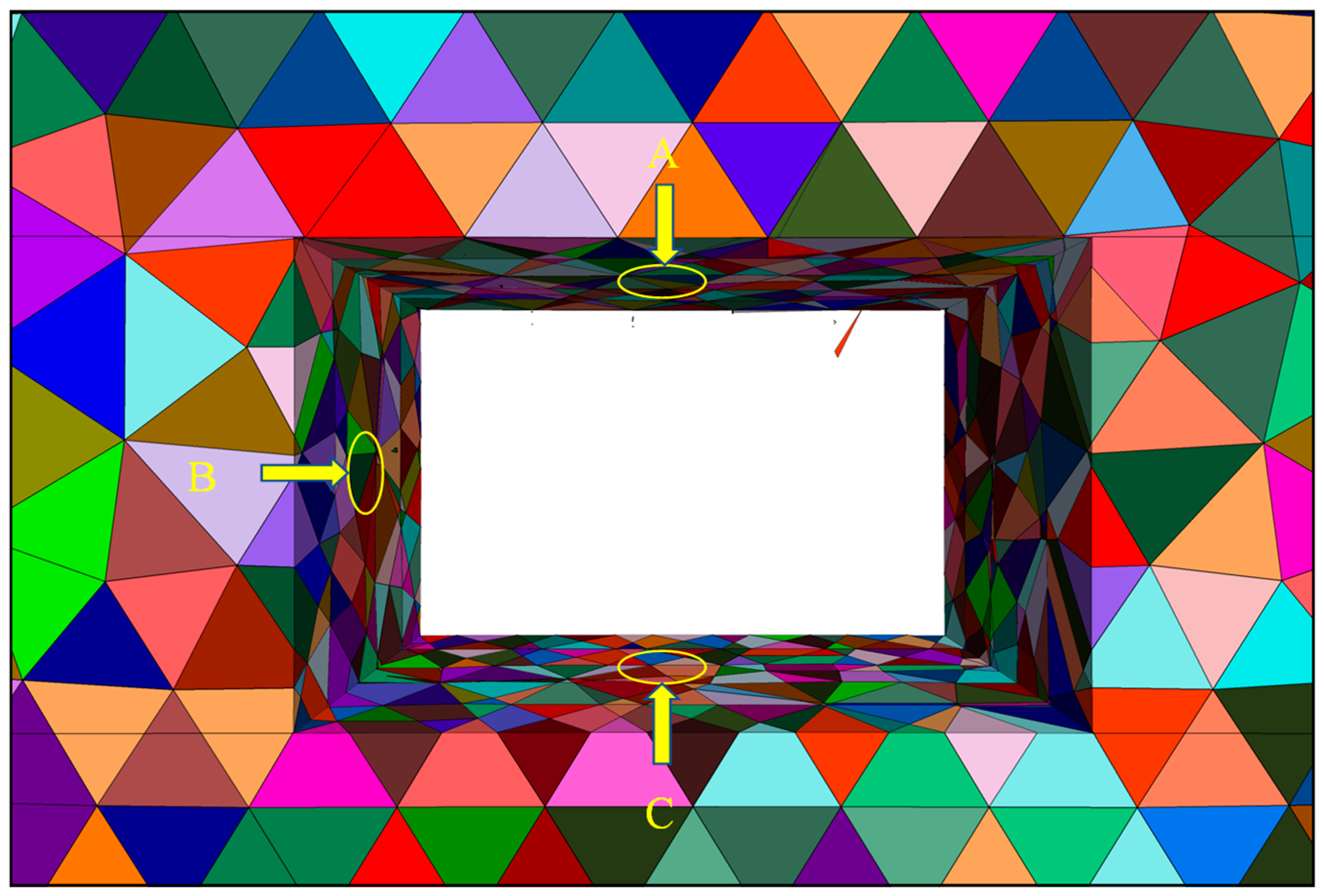
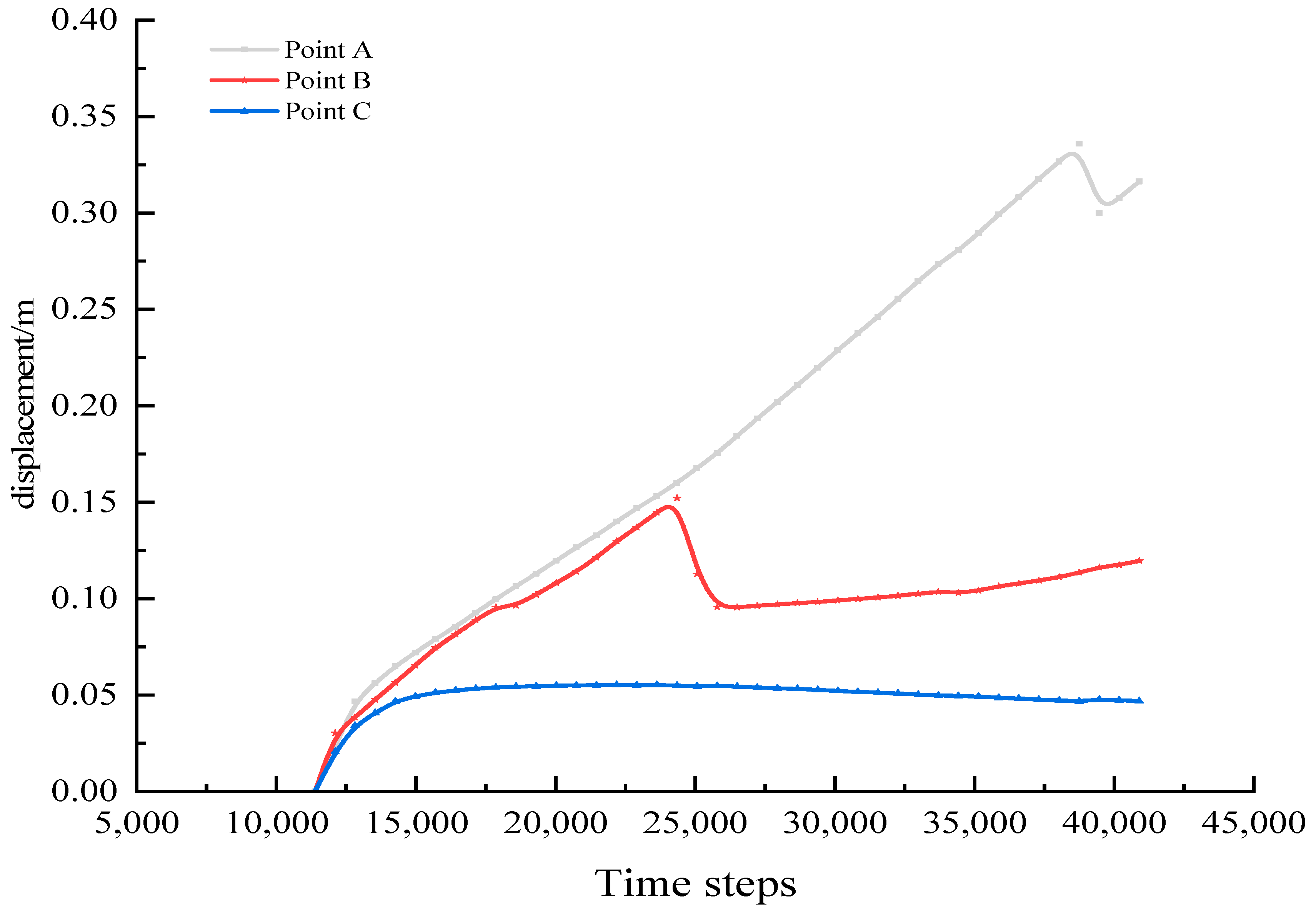
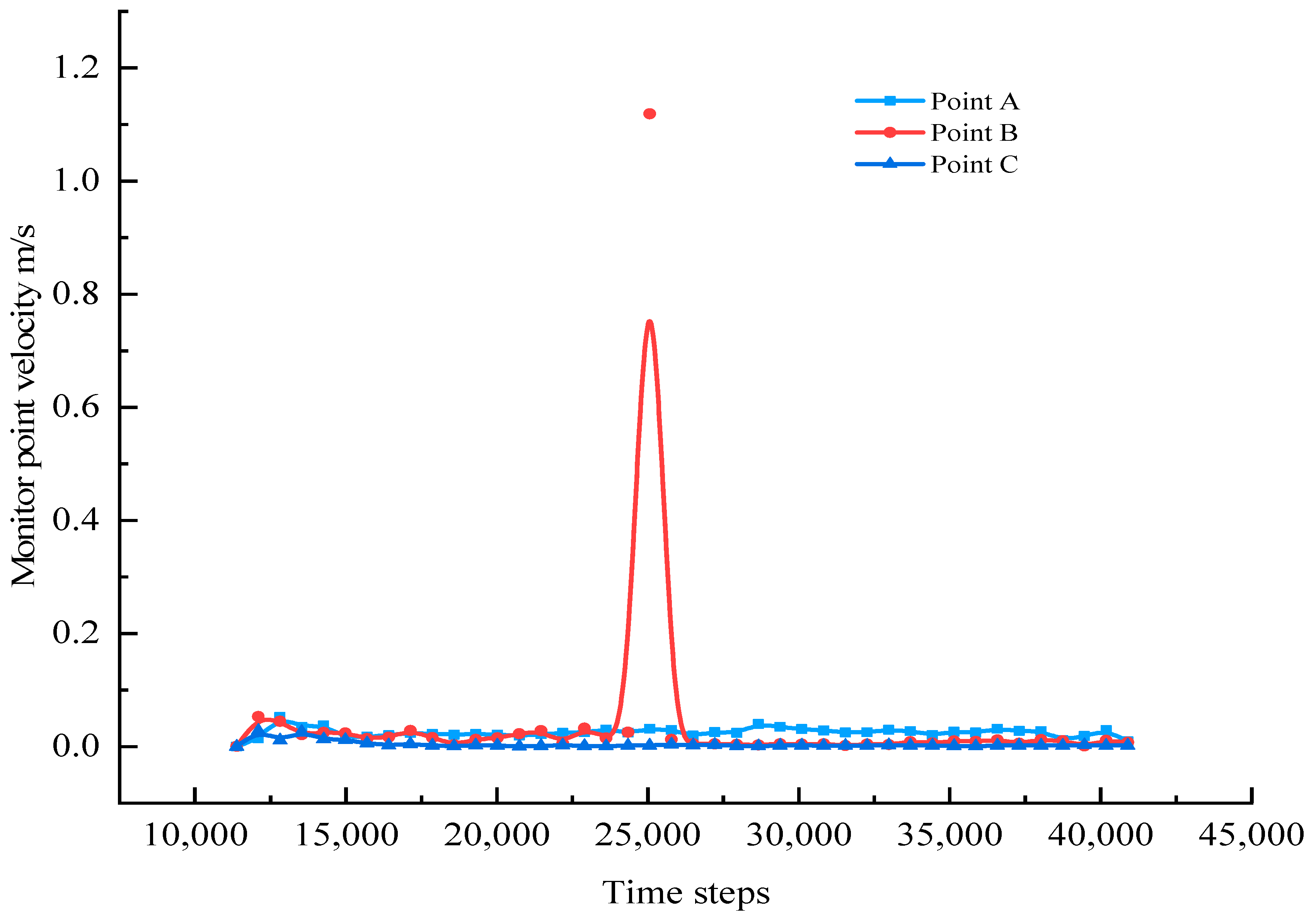
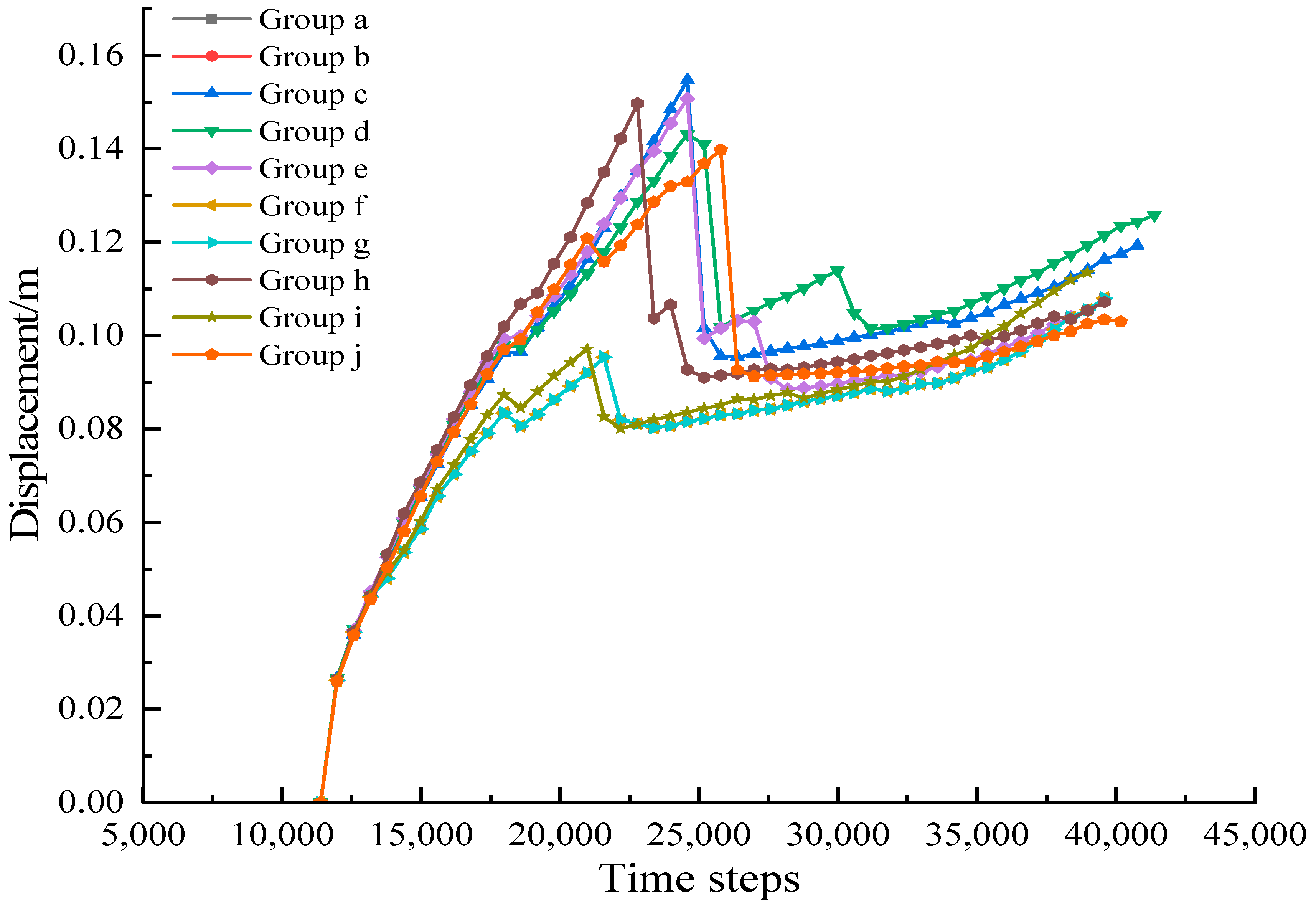
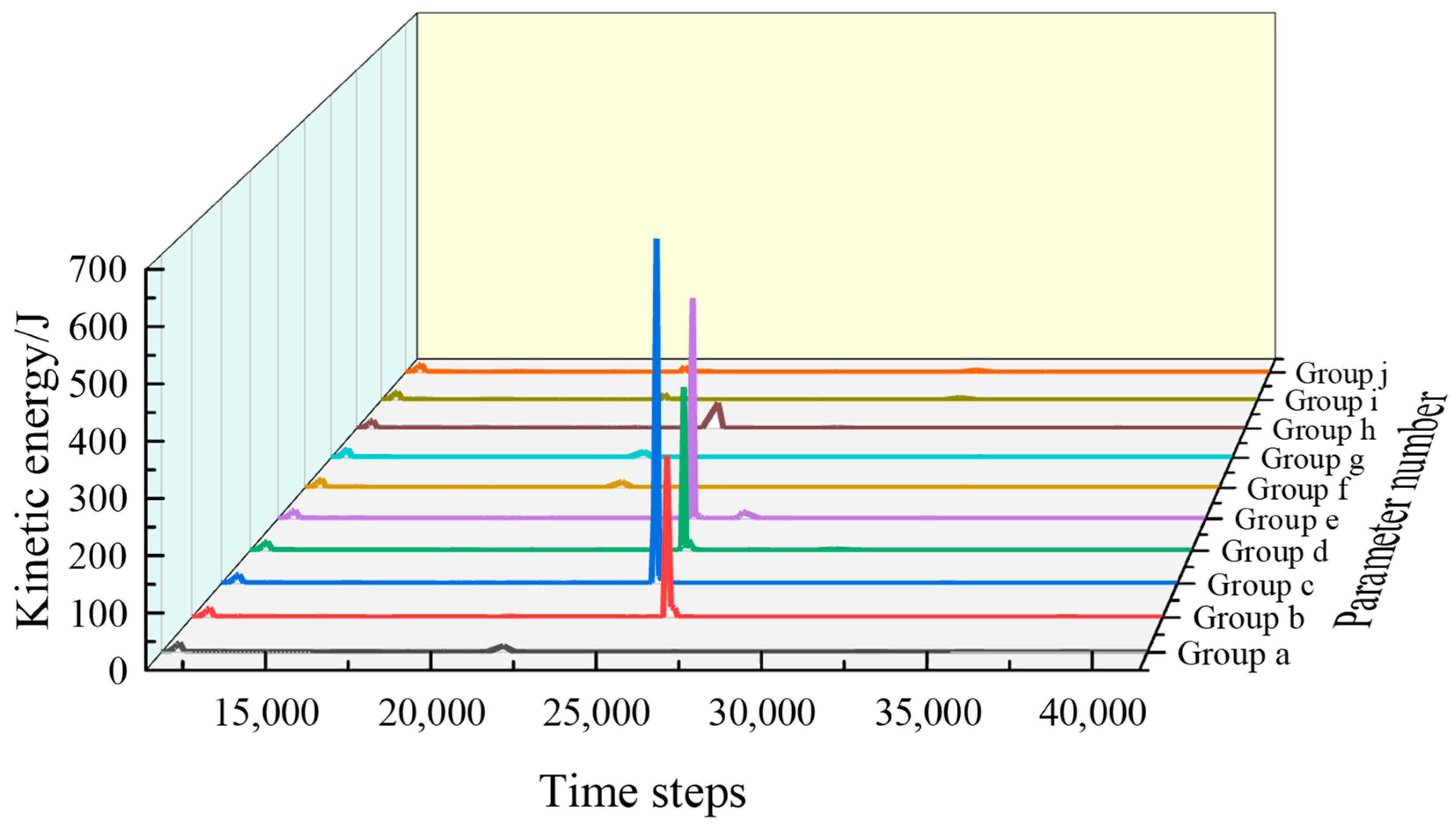
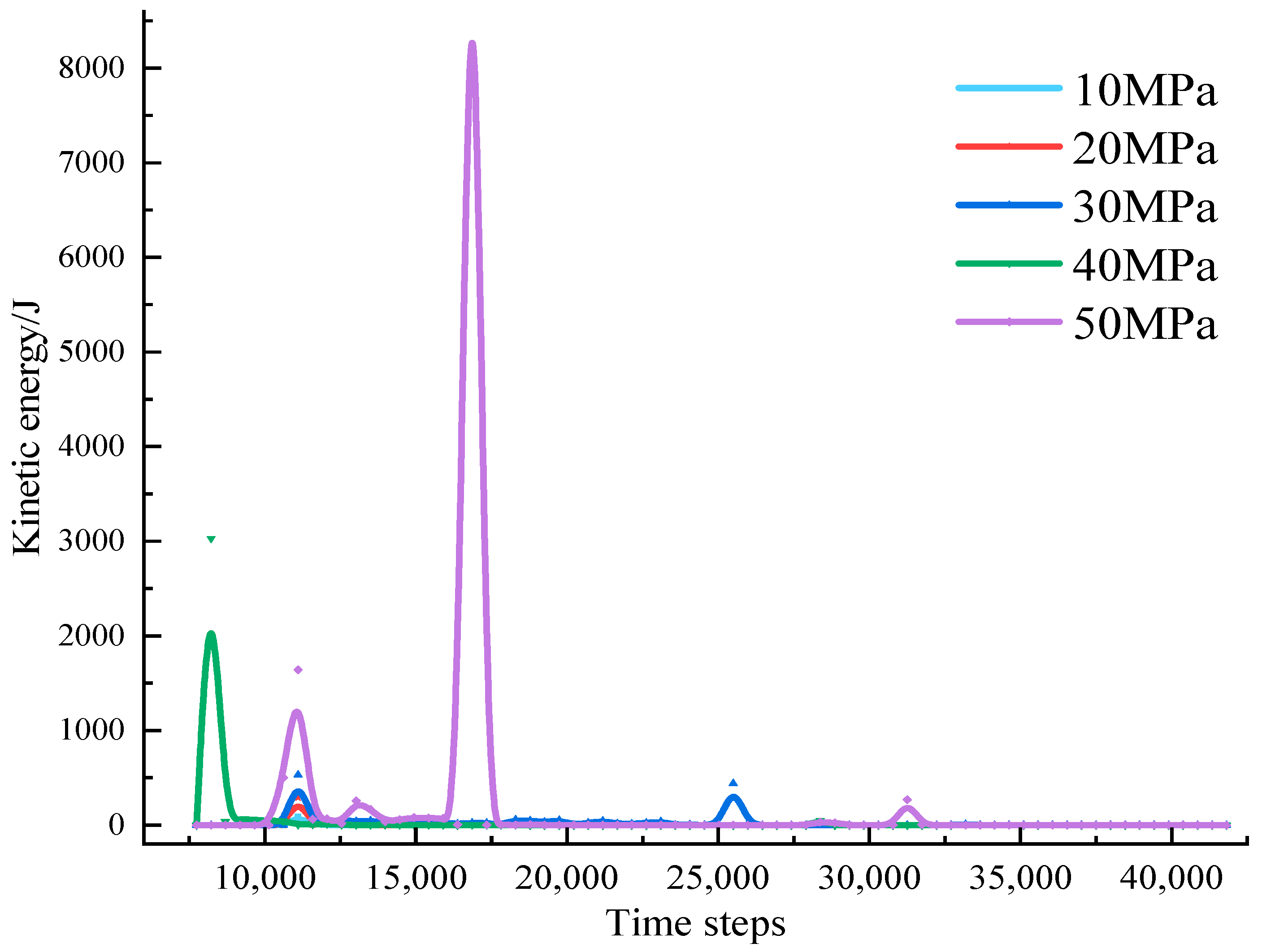
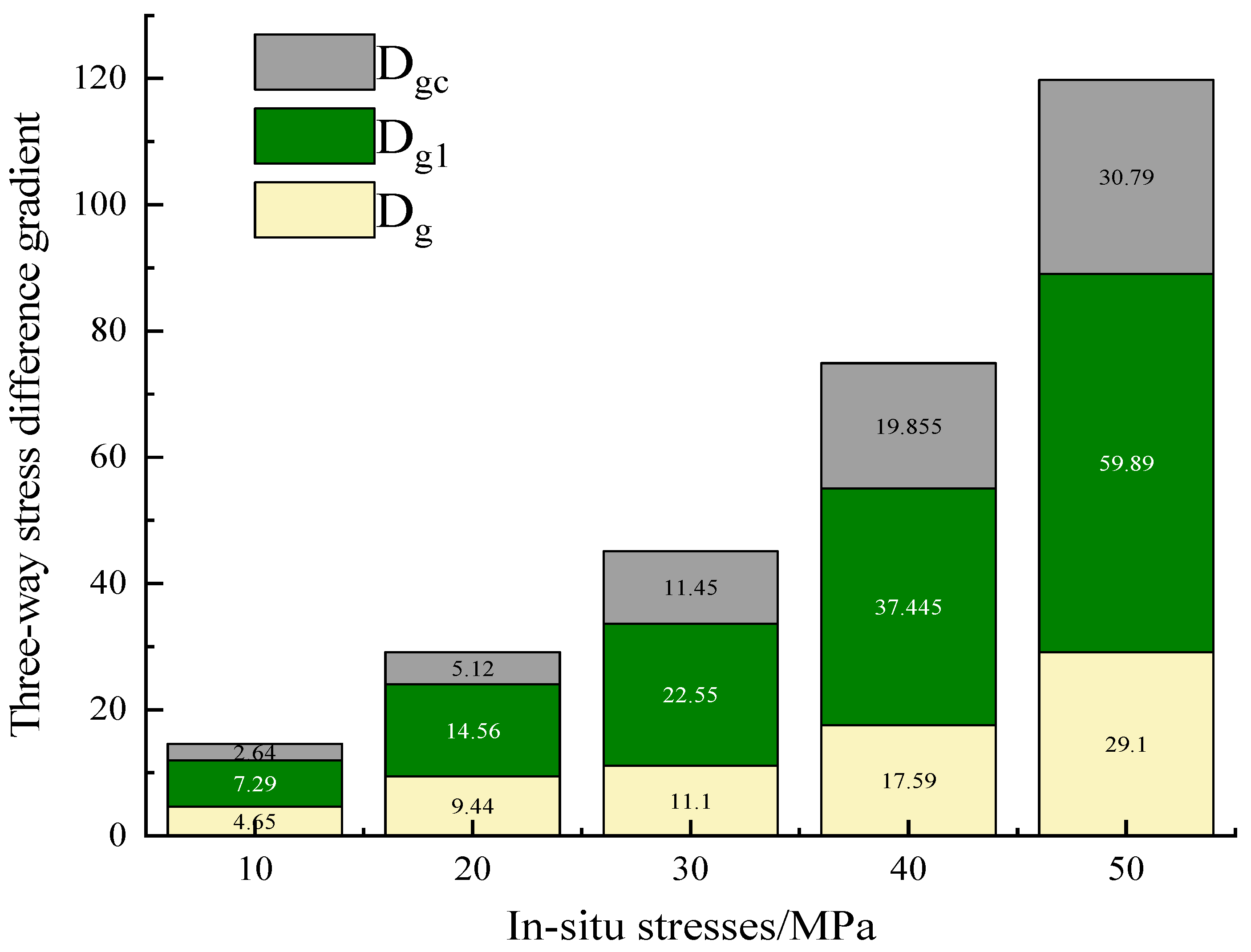
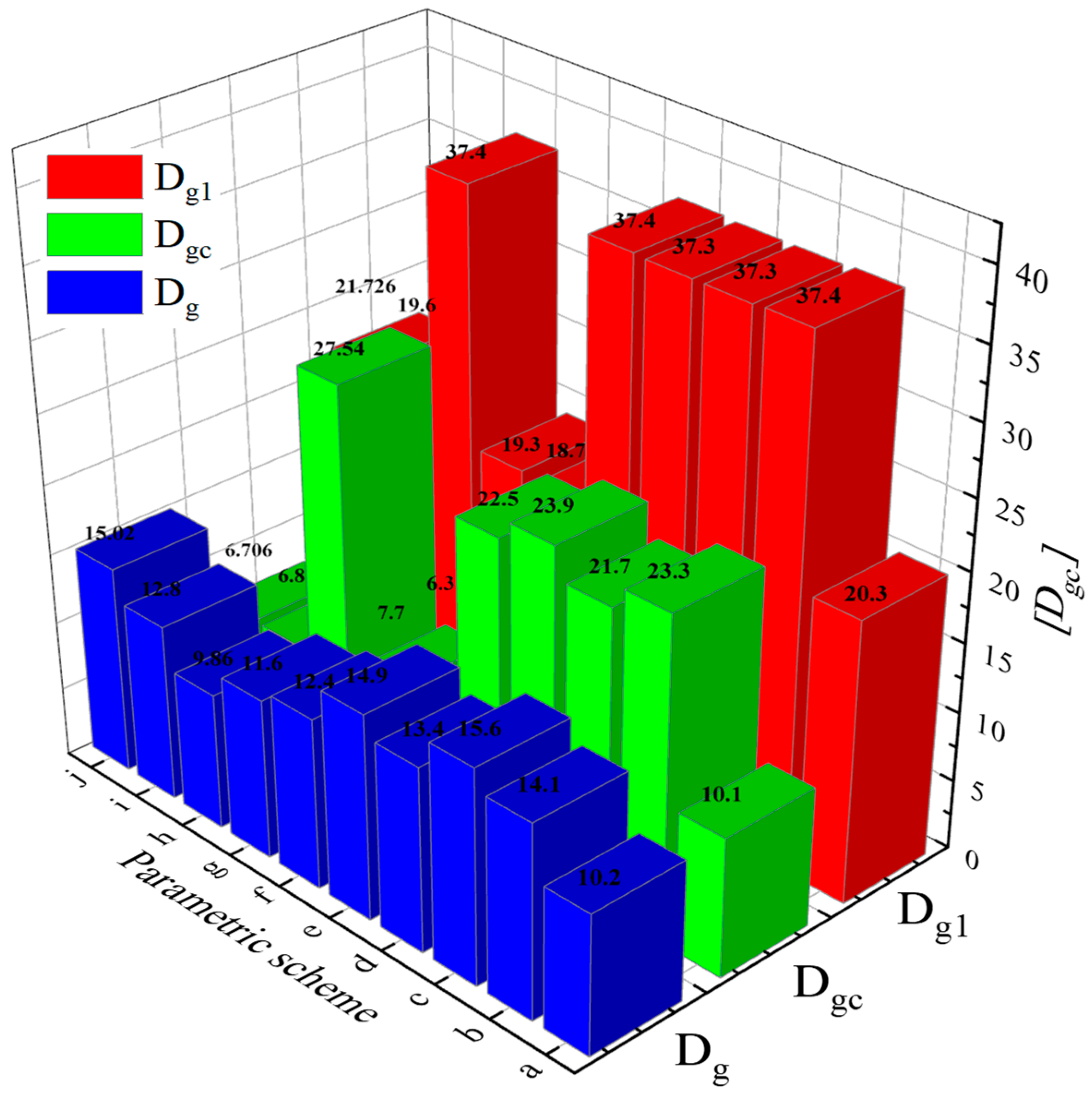
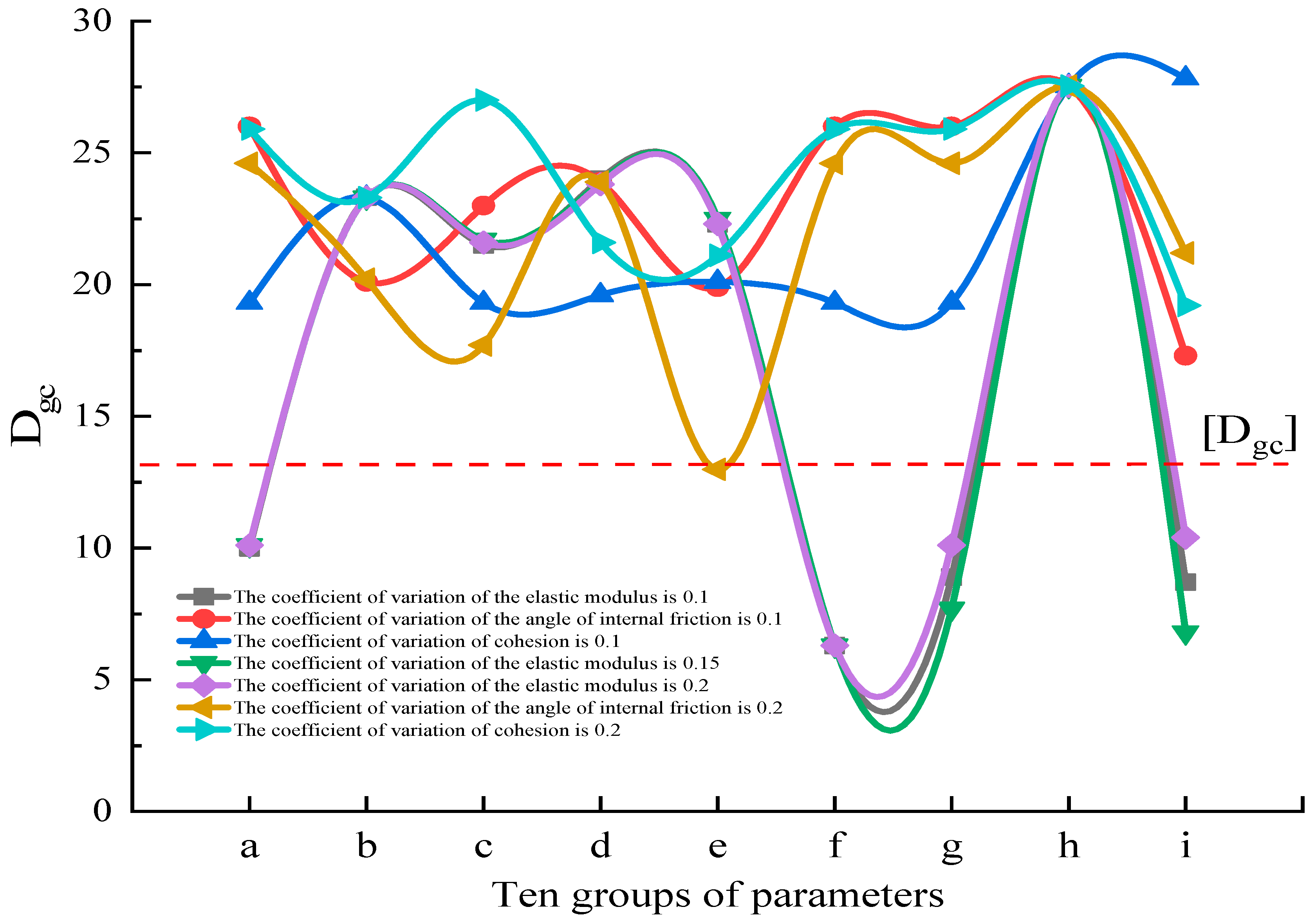
| Height/m | The Name of the Rock Formation | Density/ (kg/m3) | Modulus of Elasticity/ GPa | Shear Modulus/ GPa | Bulk Modulus/ GPa | Poisson’s Ratio |
|---|---|---|---|---|---|---|
| 10 | upper roof | 2560 | 27.5 | 11.08 | 18.41 | 0.26 |
| 6.4 | immediate roof | 2500 | 9.6 | 3.87 | 8.2 | 0.28 |
| 9.6 | coal seam | 1400 | 3.1 | 1.25 | 3.02 | 0.31 |
| 4 | immediate bottom | 2500 | 9.6 | 3.87 | 8.2 | 0.28 |
| 10 | basic bottom | 2560 | 27.5 | 11.08 | 18.41 | 0.26 |
| The Name of the Rock Formation | Normal Stiffness/ GPa | Tangential Stiffness/ GPa | Internal Friction Angle/° | Adhesion/ MPa | Tensile Strength/ MPa |
|---|---|---|---|---|---|
| upper roof | 5100 | 2100 | 25 | 10.2 | 5.6 |
| immediate roof | 3200 | 1400 | 20 | 8.1 | 3.2 |
| coal seam | 2000 | 800 | 18 | 3.0 | 1.1 |
| immediate bottom | 3200 | 1400 | 20 | 8.1 | 3.2 |
| basic bottom | 5100 | 2100 | 25 | 10.2 | 5.6 |
| Mechanical Parameter | Mean μ | Standard Deviation σ | Coefficient ν |
|---|---|---|---|
| Elastic modulus /GPa | 3.1 | 0.465 | 0.15 |
| Internal friction angle /(°) | 18 | 2.7 | 0.15 |
| Cohesion /kPa | 3.0 | 0.45 | 0.15 |
| Parameter Group | (μ − 3σ, μ + 3σ) | Elastic Modulus | Internal Friction Angle | Cohesion |
|---|---|---|---|---|
| a | (−3, 3, −3) | 1.705 | 9.9 | 1.65 |
| b | (−3, −3, 0) | 1.705 | 9.9 | 3.0 |
| c | (−3, −3, 3) | 1.705 | 9.9 | 4.35 |
| d | (−3, 0, −3) | 1.705 | 18 | 1.65 |
| e | (−3, 3, −3) | 1.705 | 26.1 | 1.65 |
| f | (0, −3, −3) | 3.1 | 9.9 | 1.65 |
| g | (3, −3, −3) | 4.495 | 9.9 | 1.65 |
| h | (0, 0, 0) | 3.1 | 18 | 3.0 |
| i | (3, 3, 3) | 4.495 | 26.1 | 4.35 |
| j | (0, 3, 3) | 3.1 | 26.1 | 4.35 |
Disclaimer/Publisher’s Note: The statements, opinions and data contained in all publications are solely those of the individual author(s) and contributor(s) and not of MDPI and/or the editor(s). MDPI and/or the editor(s) disclaim responsibility for any injury to people or property resulting from any ideas, methods, instructions or products referred to in the content. |
© 2024 by the authors. Licensee MDPI, Basel, Switzerland. This article is an open access article distributed under the terms and conditions of the Creative Commons Attribution (CC BY) license (https://creativecommons.org/licenses/by/4.0/).
Share and Cite
Yang, Y.; Li, N. Quantitative Assessment of Rock Burst Risk in Roadway Tunneling Considering Variation of Coal Mass Parameters. Appl. Sci. 2024, 14, 8211. https://doi.org/10.3390/app14188211
Yang Y, Li N. Quantitative Assessment of Rock Burst Risk in Roadway Tunneling Considering Variation of Coal Mass Parameters. Applied Sciences. 2024; 14(18):8211. https://doi.org/10.3390/app14188211
Chicago/Turabian StyleYang, Yu, and Ning Li. 2024. "Quantitative Assessment of Rock Burst Risk in Roadway Tunneling Considering Variation of Coal Mass Parameters" Applied Sciences 14, no. 18: 8211. https://doi.org/10.3390/app14188211
APA StyleYang, Y., & Li, N. (2024). Quantitative Assessment of Rock Burst Risk in Roadway Tunneling Considering Variation of Coal Mass Parameters. Applied Sciences, 14(18), 8211. https://doi.org/10.3390/app14188211





